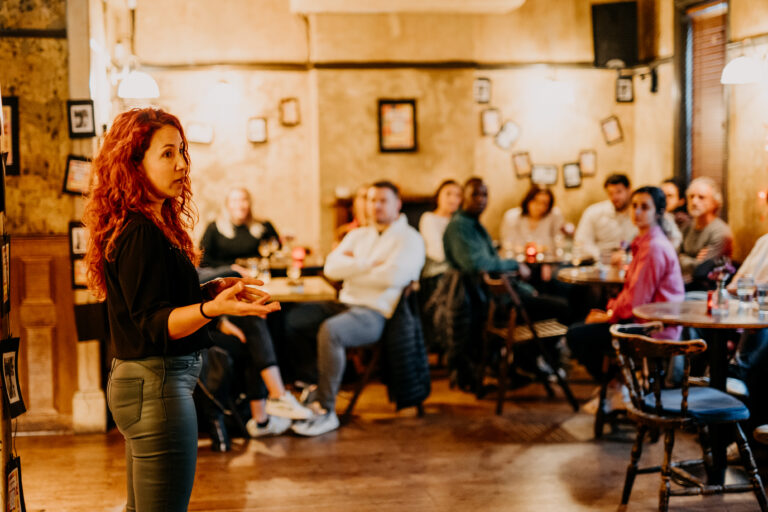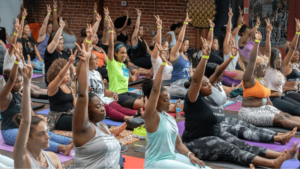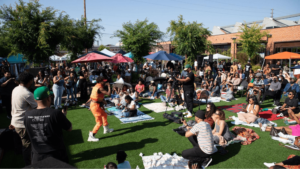Behavioural science seeks to understand how people behave – including decision making processes; memory; and emotions – and identifies cognitive biases – or mental shortcuts – which our brains make to simplify the world around us. Within behavioural science, behavioural economics is a more refined set of principles which refer more specifically to people’s economic decision making. Also within behavioural science is the study of behaviour change, consisting of frameworks and interventions to deliver the desired behaviour.
Examples of all these disciplines can be seen across our everyday lives – from city planning, to public health interventions – to product design, advertising and marketing – and whether we realise it or not, they heavily influence how we think and act.
In this series you can learn how to harness behavioural science as you build your community and deliver events. From event concept to promotion strategy, targeted nudges can change how your audience behaves, helping you to build community and sell more tickets.
Building and harnessing a community is invaluable for event creators. Attracting the right people helps take your events to the next level. Using behavioural insights, you can discover which tactics can be effective at inciting event-goers to identify with your mission.
3 Tips to Build your Community
1. Liking
In his book ‘Influence’, Psychology Professor Robert B. Cialdini, set out six principles which each describe a method of persuasion. ‘Liking’ is one such technique, which refers to the fact that we are more likely to buy from people we connect with. Whether this is a shared interest, opinion, trait, or characteristic, we are more likely to say ‘yes’ to people who are like us. This is also known as the ‘similar to me’ or affinity bias. Company website ‘about us’ pages are a great example of how organizations humanise their brands to increase liking.
Increased familiarity through repeated contact is another way to encourage ‘liking’ – in marketing terms this relates to the ongoing drumbeat of social content you share in between events to build familiarity. ‘Association’ is another ‘liking’ mechanism – where we are more likely to be open to an idea when it’s introduced to us by someone we already know. Association plays a particularly important role when building your event brand and relates to the power of social sharing and word of mouth in spreading the word about your events.
Concept to action
Sharing your story and purpose as part of your event narrative provides a greater chance for event goers to identify with you and your mission. Including bios of yourselves and your team across your assets is another simple way to humanise your events so attendees can relate.
Think about both online and offline word of mouth as part of your community building strategy. Focusing on the small details to ensure an event experience your attendees will want to tell their friends about is also a classic and surefire way to ensure word of mouth about your event travels. Consider what mechanisms will encourage your attendees to spread the word. This could include incentivising or reminding ticket buyers to tell their friends, or by creating at-event social sharing opportunities – photo backdrops, visible hashtags etc.
Selecting the right channels for promotion can supercharge your community building efforts. Kayleigh Potter, one of the organizers of global community Women in Climate, says:
“LinkedIn is our primary channel because that enables us to expand and connect with new members. We’re in a high growth phase launching in lots of new cities, and each time we launch we use an event (such as our dinner format) to bring new members together.”

2. Social proof
Social proof is one of the best known behavioural science concepts. Another of Cialdini’s principles of influence, it is widely visible across marketing and advertising campaigns. It describes the way we look around to see how others behave to inform our own behaviour, with actions carried out by large numbers of people instinctively perceived to be correct.
Examples of social proof
For example, when we’re told, “95% of consumers prefer the taste of our product”, social proof is being used to influence our decision making. It also refers to the way we increasingly make buying decisions based on the reviews and experiences of others: online retailers harness this instinct when they shape the shopping experience with reviews positioned front and centre. Case studies are another powerful marketing tool which build off the social proof principle. In describing a customer experience in detail they provide a proof point of the product in action. The carousel of ‘brands we work with’ is another prevalent example of social proof in action.
Concept to action
Including event attendee testimonials, quotes and pictures on your event page and social media promotion are a great way to demonstrate social proof so future event goers know what to expect. Identifying partners, speakers and influencers with larger social followings, and building some social outreach as part of your collaboration, can also demonstrate social proof and help kickstart your community building when you’re starting out.
3. Framing
One of the grandfathers of behavioural economics, Daniel Kahneman identified that when choices are presented to highlight the positive or negative aspects of the same decision, this determines how attractive they are in the minds of the buyer. This concept is known as ‘framing’ and is widely used in messaging and product positioning.
Examples of Framing
The notion of buying a raffle ticket with a 10% chance to win £100 – vs a 90% chance of losing £5 is an obvious example. More subtler framing examples are applied when we are invited to select a ‘starter’, ‘standard’, or ‘premium’ pricing plan for a software service, with specific benefits typically framed within the middle option. Understanding the motivations of the target audience is key to applying framing in a way that will deliver the desired audience response.
Concept to action
Sometimes the smaller details make a big difference. The creators of wine education event, Wineknow, saw a noticeable uptick in conversions from page views to ticket sales when they reframed the positioning of their event. Sarah from the event, says:
“For our first event we were keen to communicate the difference we were trying to create in building a wine event that stood for inclusivity and sought to democratise wine. But we stating this alone didn’t seem to be getting our point across. It was only when we shifted our description to set out what we weren’t – and how what we were doing differed from other events – that we saw page views convert to ticket sales. The original blurb opening sentence read, “A new event series making wine education inclusive and sociable”. Reframed, this now reads, “Love wine and want to know more, but put off by the uptight and non inclusive vibes of some wine tasting events?”

Conclusion
The ways your community engages with your offering and makes buying decisions centres around a set of behavioural patterns, some of which have been described here. Leveraging these as you plan your next event will help you build your community and present your concept and pricing in ways that are likely to strengthen your appeal and build your event brand. Stay tuned for our next edition of exclusive psychology tips.
Feeling inspired? Start planning and organising your next event with Eventbrite.





